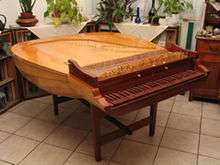Lautenwerck
The lautenwerck (also spelled lautenwerk), alternatively called lute-harpsichord (lute-clavier), is a European keyboard instrument of the Baroque period. It is similar to a harpsichord, but with gut rather than metal strings, producing a mellow tone.

Lautenwerck
The instrument was favored by J. S. Bach, who owned two of the instruments at the time of his death, but no specimens from the 18th century have survived to the present day.[1] It has been revived since the 20th century by harpsichord makers Willard Martin, Keith Hill and Steven Sorli. Two of its most prominent performers are the early music specialists Gergely Sárközy and Robert Hill.
Media
Performances by Gergely Sárközy are also freely available.[2]
Notes
- Henning, p. 477
- Including BWV 996 - Prelude-Presto and BWV 996 - Bourree, both via Archive.org
gollark: You have ten times as many unnamed dragons as I have dragons.
gollark: Well, being a programmer, yes; my code is full of them.
gollark: Great, I missed BuG.
gollark: \g
gollark: I guess this is the apocalypse.
References
- Henning, Uta (October 1982). "The Most Beautiful Among the Claviers: Rudolf Richter's Reconstruction of a Baroque Lute-Harpsichord". Early Music. 10 (4): 477–486. doi:10.1093/earlyj/10.4.477. JSTOR 3126936.
External links
| Wikimedia Commons has media related to Lautenwerck. |
- Lautenwerck page
- Information (Tihamér Romanek)
- Gallery of pictures and sounds (Stevie Sorli)
This article is issued from Wikipedia. The text is licensed under Creative Commons - Attribution - Sharealike. Additional terms may apply for the media files.
